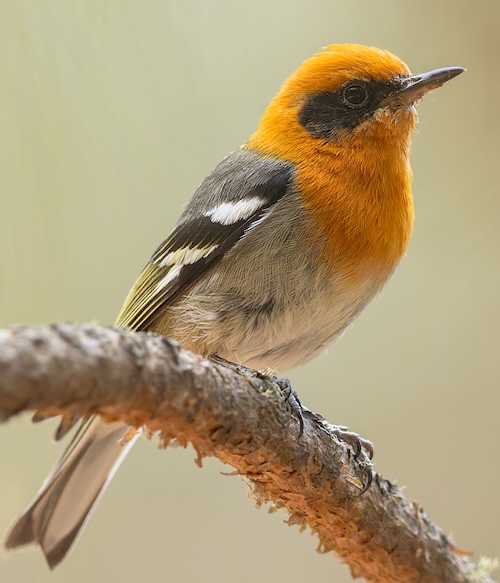Peucedramidae – Olive Warbler

The Olive Warbler Peucedramus taeniatus is a small passerine bird. It is the only member of the genus Peucedramus and the family Peucedramidae.
It breeds from southern Arizona and New Mexico, USA, south through Mexico to Nicaragua. It is the only bird family endemic to North America (including Central America). In the past, it was classed with the Parulidae (New World warblers), but DNA studies suggest that it split early from the other related passerines, prior to the differentiation of the entire New World warbler/American sparrow/Icterid group. It is therefore now given a family of its own.
It is an insectivorous species of coniferous forests. Though it is often said to be non-migratory, most New Mexican birds leave the state from November to late February. It lays 3 or 4 eggs in a tree nest.
It is a medium-sized warbler, 13 to 14 cm in length and weighing 9.5 to 12 g. It shows clinal variation in size, with more northern populations being larger than southern ones (Bergmann’s rule). It is a long-winged bird. The plumage of the male is mostly grey body with some olive-green on the wings and two white wing bars. The male’s head and breast are tawny-orange, and there is a black patch through the eye. In the female and juvenile, the orange is replaced by yellow, and the black mask is more diffuse. In addition to differences in size, plumage varies geographically as well, with southern birds having more brightly coloured plumage.
The song consists of clear whistles rendered as: hirrJI hirrJI hirrJI, plida plida plida chir chir, etc. The male sings throughout the year, with the frequency of the singing increasing in late winter and reaching a peak in early spring. During the year the male sings the most during the midmorning, but during spring the male sings constantly during mornings and late afternoon. Song is usually delivered from the canopy or other tall trees.
It is distributed from the United States to Nicaragua, making it the only bird family endemic to North America. In the northern part of its range, it has a continuous distribution from Yavapai County, Arizona and the southwestern tip of New Mexico along central Mexico to southern Mexico. There are also isolated populations in Tamaulipas, Coahuila, Sonora and Chihuahua. Further south it occurs in southwest Guatemala and from northern El Salvador and central Honduras to northern Nicaragua.

Olive Warbler Peucedramus taeniatus – ©Dubi Shapiro
The Olive Warbler is a bird of mountains and highlands. In northern areas of its range, it occurs from 2,600m above sea level or more, in some parts of its range it may not occur below 3,500m. In Oaxaca, Mexico it occupies a range of between 1,700m to 3,000m further south in Guatemala it ranges down to 1,850m and at the southern end of its range it can be found as low as 1,000m in Honduras and in Nicaragua it occupies a belt of forest from 1,070m and 1,370m.
They typically inhabit conifer forests, such as ponderosa and sugar pine forests in Arizona, Abies common fir forests, oak, and pine forests in central Mexico, Guatemala, and Honduras. These forests range from humid to semi-arid. In coastal regions stands of palms may be used, and in the Valley of Mexico pine and alder forests are inhabited.
Over most of its range the species is resident, but there is evidence that the most northerly populations are partial migrants. Birds in Arizona, New Mexico, and Mexico apparently move away from their breeding grounds, although what exact movements are made is still unclear. It has been suggested that they are either down slope migrants, moving to lower elevations, or dispersive, as some records show their presence in Texas. Birds attributed to the northern race P. t. arizonae have been recorded near Tepic, in Nayarit. Nevertheless, some birds remain in the northern areas of their range year-round.
The newly delineated family Peucedramidae was created when it was discovered, through DNA sequencing that the Olive Warbler was not, as supposed, in the family of New World Warblers but substantially different to warrant re-classification as a family by itself.
-
Number of bird species: 1
(As at October 2025)
As Peucedramidae is a newly delineated, single species family, only discovered through DNA sequencing we list the various sub-species pending further research.
Olive Warbler Peucedramus taeniatus
Subspecies:
Peucedramus taeniatus taeniatus
Peucedramus taeniatus arizonae
Peucedramus taeniatus jaliscensis
Peucedramus taeniatus giraudi
Peucedramus taeniatus micrus
-
Peucedramidae
Family AccountBedecked with a tawny-orange hood and snappy black mask, the male of this species holds forth from pine groves in the mountains of the southwestern United States and Mexico
-
Olive Warbler Peucedramus taeniatus
Species AccountThe Olive Warbler is a small passerine that is primarily resident in pine-oak forests of mountains from southeastern Arizona to Nicaragua… -
Olive Warbler Peucedramus taeniatus
Species AccountSmall songbird of mountainous coniferous forests. Males have an orange head with dark cheeks; otherwise gray with bold white wingbars. -
Olive Warbler Peucedramus taeniatus
Species AccountThe olive warbler (Peucedramus taeniatus) is a small passerine bird. It is the only member of the genus Peucedramus and the family Peucedramidae. -
Olive Warbler Peucedramus taeniatus
Species AccountSound archive and distribution map.
